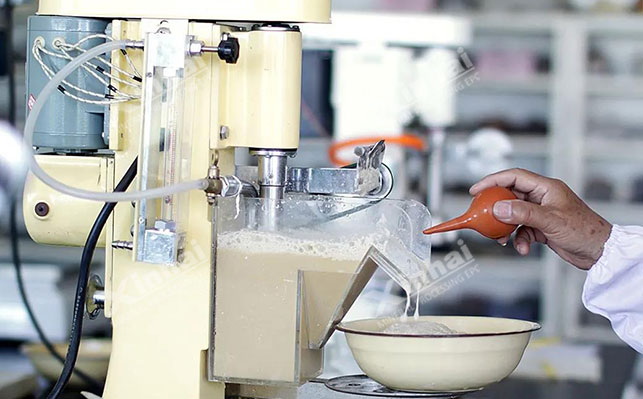Mineral resources in nature are abundant, and there is a wide variety of minerals. Some minerals have low contents of useful components, and their compositions are complex. High-quality and useful mineral products can be obtained through mineral processing. The ore beneficiation process plays a crucial role in the quality and efficiency of mineral processing. The determination of the beneficiation process relies on the results of ore beneficiation tests. Therefore, ore beneficiation tests hold a significant position in gravity separation, flotation, magnetic-electric separation, and comprehensive ore beneficiation processes. The following text will introduce the role and application of mineral beneficiation tests in various ore beneficiation processes.

The Role of Ore Beneficiation Tests in Flotation Processes Flotation separation tests involve three steps: studying ore sample properties, experimental content and results, and sorting out and optimizing the test process.
(1) Studying Ore Sample Properties: This involves studying ore properties, including ore types, structural characteristics, ore composition, and original ore chemical composition analysis.
(2) Experimental Content and Results: Considering the different properties of various ores to improve the concentrate grade, one can design roughing condition tests and stage grinding and stage separation tests.
(3) Sorting Out and Optimizing Test Processes: Conducting comprehensive tests on ores can determine a reasonable separation process. Closed-circuit tests based on open-circuit tests can verify the feasibility of ore beneficiation tests. Then, analyze the recovery rate and concentrate loss rate to determine the success of ore beneficiation tests.
The Role of Ore Beneficiation Tests in Gravity Separation Processes There are four steps in gravity separation ore beneficiation tests: studying sample properties, heavy liquid separation tests, determining the upper limit of particle size for gravity separation tests and result prediction, and gravity separation tests and results.
(1) Studying Sample Properties: After sampling from the mining field, the original ore needs to undergo crushing, screening, and shrinking. After dividing the original ore into several samples, study and analyze the composition, physical and chemical properties.
(2) Heavy Liquid Separation Tests: Conduct separation tests on a certain amount of original ore to obtain various particle-sized minerals.
(3) Determining the Upper Limit of Particle Size for Gravity Separation Tests and Result Prediction: Screen the products at different particle sizes, from coarse to fine, and analyze the trend of ore beneficiation results based on the results of heavy liquid separation and particle size analysis. Therefore, gravity separation can remove some tailings and select some concentrates, and the generated medium ore needs to undergo flotation processing again.
(4) Gravity Separation Tests and Results: Regardless of the chosen gravity separation method, a narrower range of theoretical inclusions in the original ore is better. In practical production, multiple and narrow particle size levels will complicate the separation process and increase the number of devices. Based on the results of ore beneficiation tests, a reasonable and efficient ore beneficiation process can be developed.
The Role of Ore Beneficiation Tests in Magnetic Separation Processes Magnetic separation ore beneficiation tests are divided into two steps: studying sample properties and ore beneficiation test research.
(1) Studying Sample Properties: Mainly determining the mineral composition, analyzing the mineral phases, and identifying the main mineral characteristics.
(2) Ore Beneficiation Test Research: Based on the characteristics of ore samples, determine the magnetic separation process and recovery plan. Conduct grinding fineness tests on ore samples and choose suitable grinding fineness based on various factors. The high or low magnetic field intensity during rough magnetic separation affects the grade and recovery rate of iron concentrates, so the magnetic field intensity during rough magnetic separation needs to be determined. Conduct regrinding tests on the rough concentrates, conduct scavenging on the tailings after rough selection, and then analyze the composition of the final tailings.
The Role of Ore Beneficiation Tests in Combined Ore Beneficiation Processes Combined ore beneficiation tests involve three steps: studying sample properties, determining test process flows, and determining recommended process flows.
(1) Studying Sample Properties: This involves analyzing the mineral composition and relative content of the samples and analyzing the main elements. If necessary, spectral analysis can be performed to determine harmful impurities.
(2) Determining Test Process Flows: The results of the analysis of ore sample properties can provide theoretical support for the determination of ore beneficiation processes and their sequences.
(3) Determining Recommended Process Flows: The results of the analysis of ore properties and the results of gravity separation and flotation tests are crucial for determining a reasonable ore beneficiation process flow.
The above steps and roles illustrate the significance of ore beneficiation tests in different ore beneficiation processes. The results of mineral tests provide a theoretical basis for determining mineral processing process flows. Additionally, ore beneficiation tests are a prerequisite for mineral processing in production practice. Therefore, ore beneficiation tests are a crucial step in the ore beneficiation process and hold an important position.